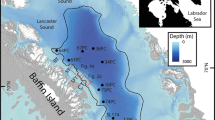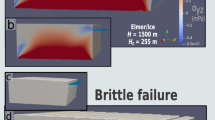Abstract
The breakup of ice shelves has been widely regarded as an indicator of climate change1, with observations around the Antarctic Peninsula having shown a pattern of gradual retreat, associated with regional atmospheric warming and increased summer melt and fracturing processes2,3,4,5,6,7,8,9. The rapid collapse of the northernmost section of the Larsen Ice Shelf (Larsen A), over a few days in January 1995, indicated that, after retreat beyond a critical limit, ice shelves may disintegrate rapidly. Here we use a finite-element numerical model that treats ice as a continuum without fracture10 to examine the breakup history2 between 1986 and 1997 of the two northern sections of Larsen Ice Shelf (Larsen A and Larsen B), from which we establish stability criteria for ice shelves. Analysis of various ice-shelf configurations reveals characteristic patterns in the strain rates near the ice front which we use to describe the stability of the ice shelf. On Larsen A, only the initial and final ice-front configurations show a stable pattern. Larsen B at present exhibits a stable pattern, but if the ice front were to retreat by a further few kilometres, it too is likely to enter an irreversible retreat phase.
This is a preview of subscription content, access via your institution
Access options
Subscribe to this journal
Receive 51 print issues and online access
$199.00 per year
only $3.90 per issue
Buy this article
- Purchase on Springer Link
- Instant access to full article PDF
Prices may be subject to local taxes which are calculated during checkout


Similar content being viewed by others
References
Mercer, J. H. West Antarctic ice sheet and CO2greenhouse effect; a threat of disaster. Nature 271, 321–325 (1978).
Vaughan, D. G. & Doake, C. S. M. Recent atmospheric warming and retreat of ice shelves on the Antarctic Peninsula. Nature 379, 328–331 (1996).
Doake, C. S. M. State of balance of the ice sheet in the Antarctic Peninsula. Ann. Glaciol. 3, 77–82 (1982).
Skvarca, P. Fast recession of the northern Larsen Ice Shelf monitored by space images. Ann. Glaciol. 17, 317–321 (1993).
Skvarca, P. Changes and surface features of the Larsen Ice Shelf, Antarctica, derived from Landsat and Kosmos mosaics. Ann. Glaciol. 20, 6–12 (1994).
Rott, H., Skvarca, P. & Nagler, T. Rapid collapse of Northern Larsen Ice Shelf, Antarctica. Science 271, 788–792 (1996).
Rott, H., Rack, W., Nagler, T. & Skvarca, P. Climatically induced retreat and collapse of Northern Larsen Ice Shelf, Antarctic Peninsula. Ann. Glaciol. 27 (in the press).
Doake, C. S. M. & Vaughan, D. G. Rapid disintegration of Wordie Ice Shelf in response to atmospheric warming. Nature 350, 328–330 (1991).
Skvarca, P., Rack, W., Rott, H. & Ibarzábal y Donángelo, T. Evidence of recent climate warming on the eastern Antarctic Peninsula. Ann. Glaciol. 27 (in the press).
Rist, M. A. et al. Experimental fracture and mechanical properties of Antarctic ice: preliminary results. Ann. Glaciol. 23, 284–292 (1996).
MacAyeal, D. R. & Thomas, R. H. Numerical modelling of ice-shelf motion. Ann. Glaciol. 3, 189–194 (1982).
Doake, C. S. M. Strain-rate trajectories and isotropic points on Filchner Ronne Ice Shelf, Antarctica. FRISP Report 10, 16–20 (1996).
MacAyeal, D. R. Atutorial on the use of control methods in ice-sheet modelling. J. Glaciol. 39, 91–98 (1993).
Bindschadler, R. A., Fahnestock, M. A., Skvarca, P. & Scambos, T. A. Surface-velocity field of the northern Larsen Ice Shelf, Antarctica. Ann. Glaciol. 20, 319–326 (1994).
Thorndike, A. S., Cooley, C. R. & Nye, J. F. The structure and evolution of flow fields and other vector fields. J. Phys. A 11, 1455–1490 (1978).
Nye, J. F. Monstars on glaciers. J. Glaciol. 29, 70–77 (1983).
Meier, M. F., Rasmussen, L. A., Krimmel, R. M., Olsen, R. W. & Frank, D. Photogrammetric determination of surface altitude, terminus position, and ice velocity of Columbia Glacier, Alaska. (Studies of Columbia Glacier, Alaska). Prof. Pap. US Geol. Surv. 1258-F (1985)).
Nye, J. F. Isotropic points on glaciers. J. Glaciol. 32, 363–365 (1986).
Frolich, R. M., Vaughan, D. G. & Doake, C. S. M. Flow of Rutford Ice Stream and comparison with Carlson Inlet, Antarctica. Ann. Glaciol. 12, 51–56 (1989).
BAS, SPRI and WCM Antarctic digital database user's guide and reference manual. (Scientific Committee on Antarctic Research, Cambridge, (1993)).
Acknowledgements
We thank D. Vaughan and colleagues at the British Antarctic Survey, and S. Marshall for comments on the manuscript. ERS radar altimetry data are copyright to ESA 1994 and 1995.
Author information
Authors and Affiliations
Rights and permissions
About this article
Cite this article
Doake, C., Corr, H., Rott, H. et al. Breakup and conditions for stability of the northern Larsen Ice Shelf, Antarctica. Nature 391, 778–780 (1998). https://doi.org/10.1038/35832
Received:
Accepted:
Issue Date:
DOI: https://doi.org/10.1038/35832
This article is cited by
-
Intense atmospheric rivers can weaken ice shelf stability at the Antarctic Peninsula
Communications Earth & Environment (2022)
-
Development of ice-shelf estuaries promotes fractures and calving
Nature Geoscience (2021)
-
Basal melting of Ross Ice Shelf from solar heat absorption in an ice-front polynya
Nature Geoscience (2019)
-
Antarctic ice shelf disintegration triggered by sea ice loss and ocean swell
Nature (2018)
-
The safety band of Antarctic ice shelves
Nature Climate Change (2016)
Comments
By submitting a comment you agree to abide by our Terms and Community Guidelines. If you find something abusive or that does not comply with our terms or guidelines please flag it as inappropriate.



